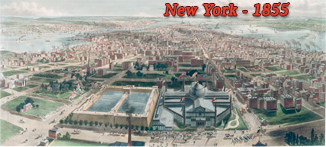
Midtown Manhattan in 19th Century
In the early 19th century, what is now Midtown Manhattan was a rural area, with poor road access. Lower Manhattan was connected to the northern part of the island by the Bowery Road, based on an old Lenape trail. There was also Bloomingdale Road (now part of Broadway), opened in the 18th century, which wandered up to near 147th Street, where it turned into the Kingsbridge Road, the old Boston Road.
The street grid system of Manhattan was introduced by the Commissioners’ Plan in 1811, seeking to provide for orderly development and land sales in Manhattan. It was a design for the streets of Manhattan above Houston Street and below 155th Street. By this plan, Bloomingdale and Bowery roads were joined at the projected Union Place, now Union Square. Bloomingdale Road continued past the 23rd Street to the site that would became Madison Square.
In 1839, the old Madison Cottage opened on the west side of Fifth Avenue, facing Madison Square, which formally opened as a public park in 1847.
The northward expansion of New York City towards Mid-Manhattan began to take shape with residents moving north about the 1840s. Several churches followed them, notably the Calvary Church Fourth Avenue at 21st Street (1848), the South Dutch Church (1849) on Fifth Avenue and 21st Street, the Marble Collegiate Church (1854) on Fifth Avenue and West 29th Street, the Madison Square Presbyterian Church (1854), the Zion Lutheran Church (1854) on Madison Avenue and East 38th Street, the Episcopal Church of the Epiphany (1856) on Lexington Avenue and 35th Street, the Brick Presbyterian Church (1858) on Fifth Avenue and 37th Street and others.
The Exhibition of the Industry of All Nations, in 1853 and 1854, was held on 42nd Street, between Fifth and Sixth avenues, next to the old Croton Reservoir, which supplied the city with drinking water from 1842 to the 1890s.
The first opening of Central Park in 1859 was a major incentive for this movement northward.
Hotels followed in the 1850s and transformed Madison Square into a hotel center in the second half of the 19th century. The Hotel St. Germain opened in 1856 on Broadway at 22nd Street, St. James Hotel (1857) on Broadway at 26th Street, the Worth House (1858) on Broadway at West 25th Street, the immense Fifth Avenue Hotel opened in 1859, Albemarle Hotel (1860) on Broadway at West 24th Street, Hoffman House (1864) on Broadway at West 25th Street, Stevens House (1872) on Broadway at 27th Street, Hotel Bartholdi (1885) on Broadway at East 23rd Street and others.
The Grand Central Depot opened in 1871, a new train station at 42nd Street and Fourth Avenue. It evolved to the Grand Central Station in 1878, the terminal for some trains of the IRT Third Avenue Line and today is the Grand Central Terminal.
Construction of the St. Patrick's Cathedral on Fifth Avenue and 50th Street began in 1858. It was dedicated in 1879, with spires added in 1888. It became the tallest structure in New York City (100.4 meters) for two years, until the rise of the World Building in 1890.
In the 1880s, theaters followed the trend toward Mid-Manhattan. The Metropolitan Opera House opened in 1883 on Broadway at West 39 Street. In the late 19th century, the northward movement continued towards the Long Acre Square, with more hotels and theaters. This development gained momentum after the first subway line opened and Long Acre Square was renamed Times Square in 1904.
On the 59th Street, at the northern end of Midtown Manhattan, several mansions were built in the 1870s and then replaced by hotels and apartment houses in the following decades.
Fifth Avenue looking south from 31st Street, about 1858. Marble Collegiate Church on right. Illustration shows stoops and small gardens in front of almost every house on the Avenue. About 1903, these spaces were removed by the city to widen the Avenue.
In 1857, the College moved from its former site at Park Place to this site between Madison and Fourth avenues (now Park Avenue), and 49th and 50th streets.

Manhattan, looking south from 42nd Street, showing the Croton Reservoir and the Crystal Palace, built for the Exhibition of the Industries of All Nations, 1853/1854.
Midtown Manhattan in 19th Century
|
Copyright © Geographic Guide - Old Manhattan NYC. |
